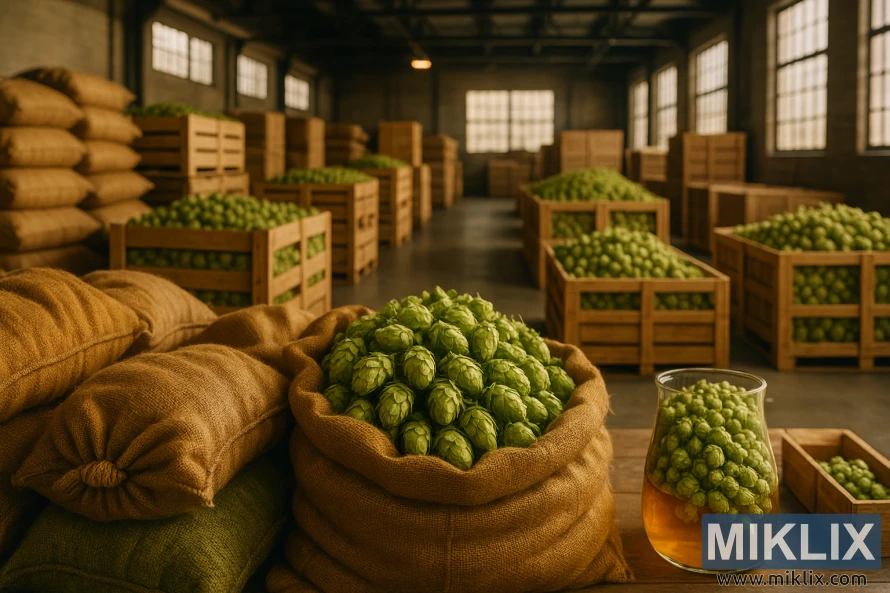Image: Columbia Hop Storage Facility
Published: July 25, 2025 at 7:51:32 AM UTC
Last updated: September 27, 2025 at 12:17:02 PM UTC
Industrial hop storage with burlap sacks and crates of fresh Columbia hops, emphasizing organization, quality, and preservation of flavor.
Inside the cavernous interior of a hop storage facility, the air is heavy with the unmistakable fragrance of freshly harvested Columbia hops. The scene opens in the foreground with a stack of burlap sacks, their coarse fibers and earthy tones providing a rustic contrast to the vibrant green cones spilling abundantly from their folds. One sack, positioned prominently at the center, is filled to the brim, its tightly packed hops pushing upward, creating a sense of fullness and abundance. Beside it, a glass vessel contains more hops immersed in a golden liquid, glowing in the warm, diffused light streaming through the tall industrial windows. This juxtaposition between raw ingredient and processed form subtly hints at the transformation that awaits these hops—the journey from field to storage, and ultimately, to the brewing kettle where their essential oils and resins will unlock layers of aroma and flavor.
The middle ground unfolds into neat, orderly rows of wooden crates, each meticulously packed and stacked, their edges aligned with the precision of practiced hands. Some of the crates are open, revealing heaps of cones cascading upward, their papery bracts catching the light in delicate variations of green, from pale chartreuse to a deeper, more resinous hue. The organization of the crates suggests a careful balance of tradition and efficiency, a nod to both the agricultural roots of hop farming and the industrial rigor required to preserve quality at scale. The arrangement conveys not chaos, but a purposeful design, where every container is strategically placed to maximize both space and accessibility.
Further back, the expanse of the facility stretches into a symphony of shadow and light. Large multi-paned windows line the walls, their glass softened by a gentle haze of dust and natural wear. Through them, the outside world remains invisible, yet the sun filters in, bathing the interior with a golden glow that dances across the surfaces of sacks and crates alike. The interplay of illumination and shadow highlights the textured surfaces, giving weight to the stacks of burlap and depth to the wooden containers. The high ceilings arch overhead, supported by beams and girders, a reminder of the industrial backbone that underpins the agricultural bounty within.
The atmosphere of the scene is one of abundance tempered by discipline. The hops themselves, fragile and fleeting in their freshness, demand this meticulous care. Every detail—from the breathable weave of the burlap sacks that prevents moisture buildup, to the solid construction of the crates designed for stacking and airflow—speaks of the importance of preservation. In this controlled environment, the volatile compounds that give hops their pungency and character are safeguarded, ensuring that when they finally meet boiling wort, they will impart not just bitterness but the nuanced notes of citrus, spice, pine, or earthiness that define the Columbia variety.
Standing in this space, one cannot help but feel the intersection of nature and human ingenuity. Each hop cone, though small and fragile, carries immense significance for the beers it will shape. The facility itself, though industrial in its design, feels almost cathedral-like in its reverence for the crop. Here, the process is not merely about storage—it is about stewardship. The cones rest in orderly abundance, awaiting their moment to infuse creativity into the brewer’s art. The combination of warm light, fragrant air, and thoughtful organization conveys more than efficiency; it conveys respect for the agricultural cycle and a deep understanding of the role these hops will play in the broader narrative of brewing.
The image is related to: Hops in Beer Brewing: Columbia

